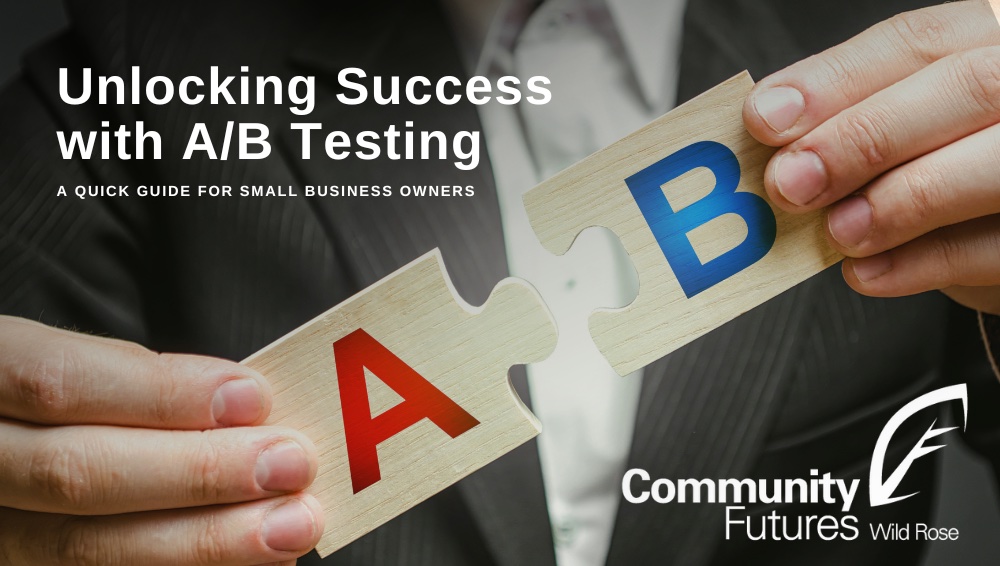What is A/B Testing?
Picture this: you have two versions of a webpage, an email, or a call-to-action button, and you’re curious which one your audience prefers. A/B testing is the way to find out! This method compares two versions (Version A and Version B) of any user experience to see which one performs better. Whether it’s your website, an email newsletter, or a product design, A/B testing can help you discover which version drives more engagement, clicks, or sales.
What Can We Use A/B Testing For?
A/B testing is a powerful tool that can enhance multiple areas of your business messaging, particularly in digital marketing. It helps improve usability (making a page easier to navigate and understand) and persuasion (influencing how visitors make decisions).
Digital marketing involves thousands of variables, even just on your website. The placement of an image, the colour of a button, or the wording of a headline can all impact your sales. A/B testing allows you to discover which version resonates better with your audience, optimizing your content for maximum effectiveness.
Here are some of the most common things A/B Testing is used for:
- Website and Landing Page Optimization: Test different headlines, images, layouts, and buttons to boost user engagement and conversions.
- Email Marketing: Experiment with subject lines, content, and design to enhance open rates and click-through rates.
- Product Features: Test new features or changes to see their impact on user satisfaction and usage.
- Pricing Strategies: Find the most effective pricing strategies for sales by testing different price points or discount offers.
- Advertising Campaigns: Optimize ad copy, images, and targeting to increase click-through rates and conversions.
How Does A/B Testing Work?
There are many types of A/B tests, and they can get increasingly complex, especially with large-scale marketing campaigns. However, let’s focus on the basics that are most useful for small businesses.
The three main categories of A/B tests are:
- Split Test: This is the most common type. You test a single variable (like a headline or button colour) by showing one version to half your audience and the other version to the rest.
- Multivariate Test: This tests multiple variables at once to see which combination works best. It's powerful but requires a lot of traffic, making it less practical for most small businesses.
- Funnel Test: This involves changing an element or design across multiple pages in a sequence (like a sales funnel) to see how it impacts user experience.
At its core, the process of each A/B test remains consistent. If you have a dedicated webmaster, they will likely handle the technical details using tools like Optimizely, Visual Website Optimizer, Lyssna, or Google Optimize. Similarly, if you have someone managing your digital marketing, they should be familiar with A/B testing for their campaigns or messaging. However, it’s still beneficial for you, the small business owner, to understand the process.
Here’s how it works:
- Formulate a Hypothesis: Start with a clear idea of what you want to test and why. For example, you hypothesize that a red call-to-action button will get more clicks than a blue one.
- Create Variations: Develop two versions for testing. Version A is your current setup (the control), and Version B includes the change you want to test (the variant). Make sure you change only one variable at a time.
- Split Your Audience: Randomly divide your audience into two groups. This split is usually done with the A/B Testing tool you are using. During the course of your test, one group sees Version A, and the other sees Version B.
- Run the Test: Show each version to its respective group simultaneously and collect data on their behaviour. Run the test for at least two weeks to get reliable results.
- Analyze Results: Use statistical analysis to see which version performed better based on key metrics like click-through rates or conversion rates. Again, this may be handled by your A/B Testing tool depending on which you use.
- Implement the Winning Variation: If one version clearly outperforms the other, roll it out to your entire audience. If you don’t see a winner, you may wish to create a new test with new options.
Is A/B Testing Good for Small Businesses?
Absolutely! Here’s why:
- Cost-Effective: Identify the most effective strategies without a big marketing budget.
- Data-Driven Decisions: Make informed choices based on actual user behaviour, not just assumptions.
- Improved User Experience: Continuously optimize to enhance customer satisfaction and loyalty.
- Increased Conversions: Even small changes can significantly impact conversion rates, driving growth.
DIY A/B Testing for Small Business
Perhaps you’re a business owner who must wear every hat—including being your own webmaster and marketing team. How can you utilize A/B Testing? Well, think of it as a controlled experiment. Think of the science experiments you did back in grade 5 where you started with a question, created a hypothesis, and ran a test. The difference is now you’re doing it for your website or email marketing campaign instead of on a plant in a pot. Use the scientific method you learned in grade school: have a control, change only one variable at a time, and compare the outcomes.
For simpler tests, you can even do it all manually! Create a single variable on a page or email (it may consist of multiple elements) that you want to test. For instance, you might want to know if a button in your email that says “Register Here” will get more clicks than one that says “Secure Your Spot for FREE.” Or, maybe you’re curious if visitors to your website’s landing page will stick around longer if you start with a large photo or with a wall of text. Make two versions, split your audience, and see which performs better!
A/B testing is a relatively low-effort, high-reward activity, especially for small businesses looking to optimize their digital presence. Some apps that can help you with your A/B Testing are VWO, Optimizely, Visual Website Optimizer, Lyssna, Kameleoon, and Google Optimize. For email marketing, check to see if your email marketing host has an A/B Testing feature! For example, check out Mailchimp’s A/B Testing interface.
And don’t worry about SEO! A/B testing doesn’t negatively affect it. Google’s Matt Cutts has cleared up that myth. The Google bots won’t index the testing variation, so you don’t need to worry about duplicate content or anything like that.
So, are you ready to see the difference A/B testing can make in your business’s online presence? Dive in and start experimenting today!
For 35 years, Community Futures Wild Rose has supported rural Alberta businesses with business planning, coaching, training, and financial support. Whether you're starting up, planning growth, or facing financial challenges, our specialists are here for you.
Schedule a FREE consultation with us at




